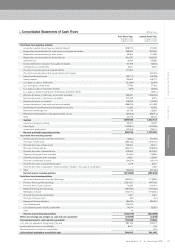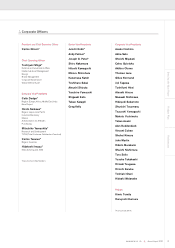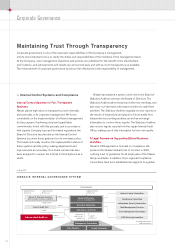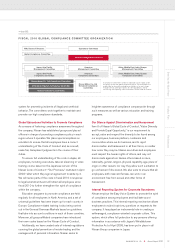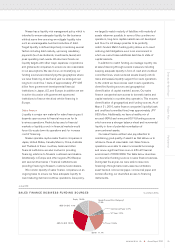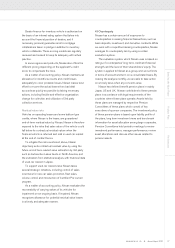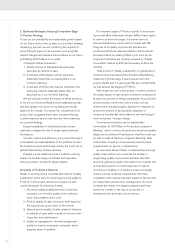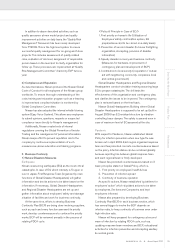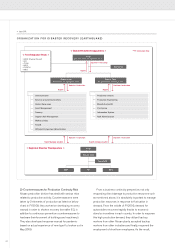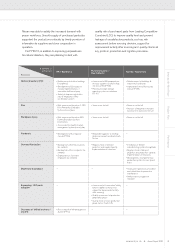Nissan 2010 Annual Report Download - page 41
Download and view the complete annual report
Please find page 41 of the 2010 Nissan annual report below. You can navigate through the pages in the report by either clicking on the pages listed below, or by using the keyword search tool below to find specific information within the annual report.
Entering the Next Phase Product Plan Performance
39Annual Report 2010NISSAN MOTOR CO., LTD.
In addition to above described activities, such as
quality assurance at new model project and quality
improvement activities on daily basis, the “Quality Risk
Management” framework has been newly developed
from FY2009. This is the high level system to ensure
successful quality management for on-going and future
projects. This includes assessment of quality related
risks, evaluation of risk level, assignment of responsible
person based on the level and to clarify organization for
follow up. These processes are implemented at “Quality
Risk Management Committee” chaired by EVP twice a
year.
3) Compliance and Reputation
As described above, Nissan produced the Nissan Global
Code of Conduct for all employees of the Nissan group
worldwide. To ensure thorough understanding of the
code, training and education program such as e-learning
is improved and compliant situation is monitored by
Global Compliance Committee.
Nissan has also adopted the internal whistle blowing
system (Easy Voice System). This allows any employees
to submit opinions, questions, requests or suspected
compliance issue directly to Nissan’s management.
Additionally, Nissan created sets of internal
regulations covering the Global Prevention of Insider
Trading and the management of personal information.
Nissan keeps effort to prevent reputation risk to the
company by continuous implementation of such
measures as various education and training programs.
3. Business Continuity
1) Natural Disasters Measures
Earthquake
Nissan is assuming earthquake (EQ) as the most critical
catastrophe. In case of EQ which intensity is 5-upper or
over in Japan, First Response Team (organized by main
functions of Global Disaster Headquarters) will gather
information and decide actions to be taken based on the
information. If necessary, Global Disaster Headquarters
and Regional Disaster Headquarters are set up and
gather information about employees’ safety and damage
situation of facilities and work for business continuity.
At the same time, efforts to develop Business
Continuity Plan (BCP) are being done involving suppliers,
such as, each and every function assessed its priority
work, develop countermeasures to continue the priority
works. BCP will be reviewed annually in the process of
rotating PDCA cycle.
<Policy & Principle in Case of EQ>
1. First priority on human’s life (Utilization of
Employees’ safety confirmation system, EQ
preparedness card to be carried on a daily basis)
2. Prevention of second disaster (In-house firefighting
organization, stockpiling, provision of disaster
information)
3. Speedy disaster recovery and business continuity
(Measures for hardware, improvement of
contingency plan and development of BCP)
4. Contribution to local society (cooperation / mutual
aid with neighboring community, companies, local
and central government)
Global Disaster Headquarters and Regional Disaster
Headquarters conduct simulation training assuming large
EQ to prepare catastrophe. The drill tests the
effectiveness of this organization and contingency plan,
and clarifies the issues to be improved. The contingency
plan is reviewed based on the feed-back.
Nissan Global Headquarters Building where Global
Disaster Headquarters is supposed to be set up (built in
August 2009) has EQ resistant structure by vibration
controlling brace damper. The safety is assured even in
case of maximum level of EQ assumed at the site.
Pandemic
With respect to Pandemic, Nissan established Global
Policy for infection prevention when new type flu. was
broken out in April 2009. Each region organized response
team and has promoted concrete countermeasures based
on the policy. Infection status can be monitored globally
because reporting line between global response team
and each regional team is firmly developed.
Nissan has promoted countermeasures based on 3
basic principles stated on Global Policy, which is,
1. First priority on employees’ health & lives
2. Prevention of infection spread
3. Continuity of business operation
As specific actions, Nissan established “guidelines for
employees’ action” which stipulated actions to be taken
by employees, Sections and Companies, and kept
employees informed.
Nissan also prepared by developing Business
Continuity Plan (BCP) in each business section, which
has several trigger to invoke the BCP depends on
infection ratio, to keep continuity of business even under
high infection ratio.
Nissan will keep prepared for contingency at second
wave of infection by rotating PDCA cycle, such as,
updating response team members and BCP, educational
activities for infection prevention and stockpiling sanitary
& medical goods.


